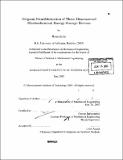Origami nanofabrication of three-dimensional electrochemical energy storage devices
Author(s)
In, Hyun Jin
DownloadFull printable version (20.20Mb)
Alternative title
Origami nanofabrication of 3D electrochemical energy storage devices
Other Contributors
Massachusetts Institute of Technology. Dept. of Mechanical Engineering.
Advisor
George Barbastathis.
Terms of use
Metadata
Show full item recordAbstract
The Nanostructured (TM) 3D Fabrication and Assembly Process was developed as a novel method of creating three-dimensional (3D) nanostructured devices using two- dimensional micro- and nanopatterning tools and techniques. The origami method of fabrication is a two-part process in which two-dimensional (2D) membranes are first patterned and then folded into the desired 3D configuration. This thesis presents an origami fabrication method based on the use of SU-8 membranes and elastic gold hinges. Magnetic actuation, stress-induced folding, vertical spacing, and lateral alignment of the membranes are discussed. This thesis also reports on the used of the Nanostructured OrigamiTM process to create a functional electrochemical energy storage device. An electrochemical capacitor, or a supercapacitor, is selected because its performance can be readily improved by the addition of 3D geometry and nanoarchitecture. In addition to improved performance, the origami fabrication method allows such devices to be integrated into preexisting MEMS and IC processes, thus enabling the fabrication of complete micro- and nanosystems with an integrated power supply. The supercapacitors were created by selectively depositing carbon-based electrode materials on the SU-8 membrane and then folding the structure so that oppositely-charged electrode regions face each other in a 3D arrangement. The fabrication process, electrochemical testing procedure, and analysis of the results are presented.
Description
Thesis (S.M.)--Massachusetts Institute of Technology, Dept. of Mechanical Engineering, 2005. Includes bibliographical references (p. 143-154).
Date issued
2005Department
Massachusetts Institute of Technology. Department of Mechanical EngineeringPublisher
Massachusetts Institute of Technology
Keywords
Mechanical Engineering.